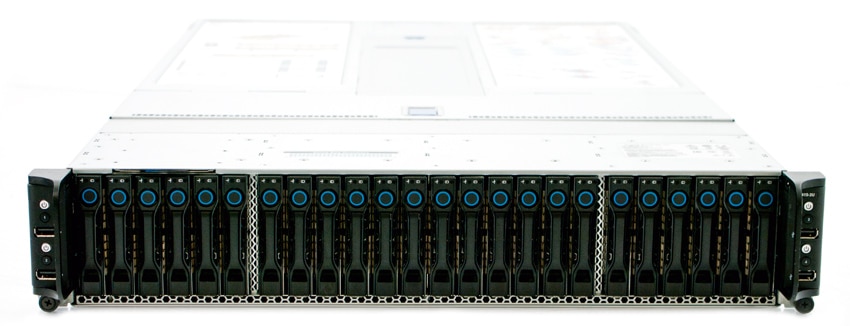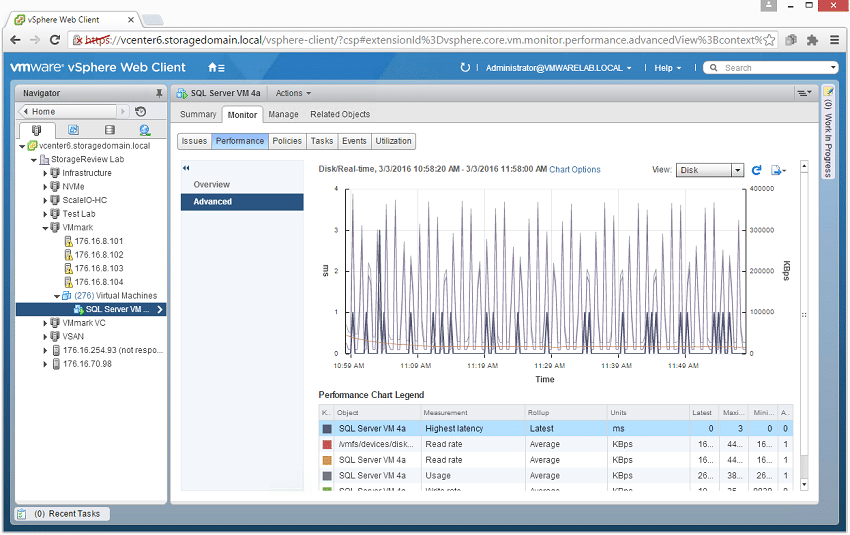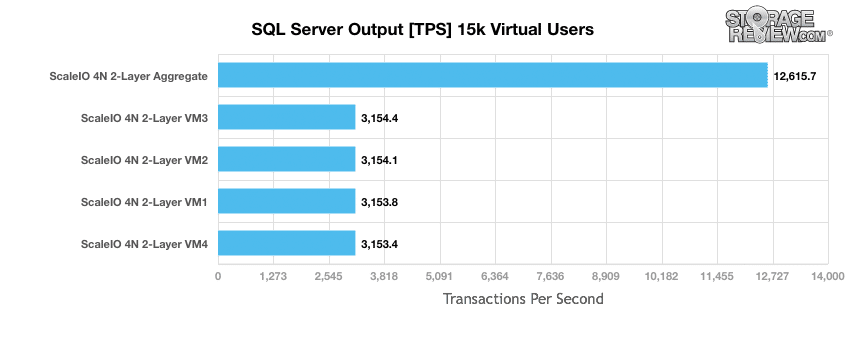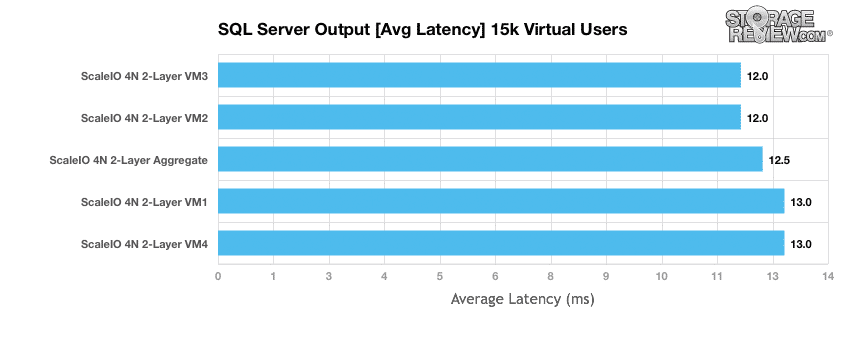After looking at scaled Sysbench performance under maximum capacity, we continue to produce database performance results on the all-flash VxRack nodes from EMC in a two-layer SAN configuration. Where we designed the Sysbench workload to show scalability of the platform, the SQL Server benchmarking is architected particularly with an eye on latency for OLTP workloads. In this case we test the system with four simultaneous transactional VMs, monitoring latency and TPC for consistency across the four.

VxRack Node (Performance Compute All Flash PF100) Specifications
- Chassis – # of Node: 2U-4 node
- Processors Per Node: Dual Intel E5-2680 V3, 12c, 2.5GHz
- Chipset: Intel 610
- DDR4 Memory Per Node: 512GB (16x 32GB)
- Embedded NIC Per Node: Dual 1-Gbps Ethernet ports + 1 10/100 management port
- RAID Controller Per Node: 1x LSI 3008
- SSDs Per Node: 4.8TB (6x 2.5-inch 800GB eMLC)
- SATADOM Per Node: 32GBSLC
- 10GbE Port Per Node: 4x 10Gbps ports SFP+
- Power Supply: Dual 1600W platinum PSU AC
- Router: Cisco Nexus C3164Q-40GE
SQL Server Performance
Each SQL Server VM is configured with two vDisks; 100GB volume for boot and a 500GB volume for the database and log files. From a system resource perspective, we configured each VM with 16 vCPUs, 64GB of DRAM and leveraged the LSI Logic SAS SCSI controller. While our Sysbench workloads tested previously saturated the platform in both storage I/O and capacity, the SQL test is looking for latency performance.
This test uses SQL Server 2014 running on Windows Server 2012 R2 guest VMs, being stressed by Dell's Benchmark Factory for Databases. While our traditional usage of this benchmark has been to test large 3,000-scale databases on local or shared storage, in this iteration we focus on spreading out four 1,500-scale databases evenly across the EMC VxRack Node to better illustrate the aggregate performance inside a 4-node VMware cluster.
SQL Server Testing Configuration (per VM)
- Windows Server 2012 R2
- Storage Footprint: 600GB allocated, 500GB used
- SQL Server 2014
- Database Size: 1,500 scale
- Virtual Client Load: 15,000
- RAM Buffer: 48GB
- Test Length: 3 hours
- 2.5 hours preconditioning
- 30 minutes sample period
SQL Server OLTP Benchmark Factory LoadGen Equipment
- Dell PowerEdge R730 VMware ESXi vSphere Virtual Client Hosts (2)
- Four Intel E5-2690 v3 CPUs for 124GHz in cluster (Two per node, 2.6GHz, 12-cores, 30MB Cache)
- 512GB RAM (256GB per node, 16GB x 16 DDR4, 128GB per CPU)
- SD Card Boot (Lexar 16GB)
- 2 x Mellanox ConnectX-3 InfiniBand Adapter (vSwitch for vMotion and VM network)
- 2 x Emulex 16GB dual-port FC HBA
- 2 x Emulex 10GbE dual-port NIC
- VMware ESXi vSphere 6.0 / Enterprise Plus 4-CPU
-
Dell PowerEdge R730 Virtualized SQL 4-node Cluster
- Eight Intel E5-2690 v3 CPUs for 249GHz in cluster (Two per node, 2.6GHz, 12-cores, 30MB Cache)
- 1TB RAM (256GB per node, 16GB x 16 DDR4, 128GB per CPU)
- SD Card Boot (Lexar 16GB)
- 4 x Mellanox ConnectX-3 InfiniBand Adapter (vSwitch for vMotion and VM network)
- 4 x Emulex 16GB dual-port FC HBA
- 4 x Emulex 10GbE dual-port NIC
- VMware ESXi vSphere 6.0 / Enterprise Plus 8-CPU
- 10GbE Switching Hardware
- Front-End Ports: Mellanox SX1036 10/40GbE Switch
- Back-End Ports: Cisco Nexus 3164 10/40GbE Switch

From a storage latency perspective, the EMC VxRack Node delivered quite well to our SQL Server VM, with average latency measuring less than 1ms, with minimal spikes to 3ms during log write activity. This snapshot was consistent across all four VMs during the SQL Server TPC-C test.
In the SQL Server TPC-C test, we look for workload balance across the cluster. With four VMs running in steady-state on four Dell PowerEdge R730 servers with storage provided from EMC's VxRack Node in two-layer, we measured performance ranging from 3154.37 TPS on the high side to 3153.44 TPS on the low side, virtually identical. In aggregate we saw cluster-wide performance measure 12,615.66 TPS on the ScaleIO cluster.

Switching focus to latency, which we regard as the most important metric in this benchmark, the EMC VxRack Node in two-layer performed very well. We measured application latency across four VMs ranging from 12ms on the low side to 13ms on the high side, offering an aggregate average of 12.5ms. Compared to other platforms we've tested with this benchmark as published on our SQL Server page, the VxRack Node performs very well. It comes in much faster than other hyper-converged platforms, slightly edges out FC-connected all-flash storage, and is only bested by locally attached NVMe or PCIe flash storage.

Conclusion
As the VxRack Node works through our testing regimen, we're again talking about the system setting records. In this case, VxRack takes top scores when it comes to SQL Server latency, meaning it's poised to deliver excellent database transactional quality. These results, in conjunction with the scalability we saw to full capacity in the Sysbench segment of this review, combine to show both the scalability and responsiveness of the system. The next segment of the review will look at VMware VMmark in SAN configuration to give a detailed look at virtualized workload performance under heavy load and capacity utilization.
Other Segments of this Review:
EMC VxRack Node Review: Overview
EMC VxRack Node Powered By ScaleIO: Scaled Sysbench OLTP Performance Review (2-layer)
EMC VxRack Node Powered By ScaleIO: Synthetic Performance Review (2-layer)
EMC VxRack Node Powered By ScaleIO Review: Synthetic Performance Review (HCI)
EMC VxRack Node Powered By ScaleIO: SQL Server Performance Review (HCI)
EMC VxRack Node Powered By ScaleIO: VMmark Performance Review (HCI)




 Amazon
Amazon